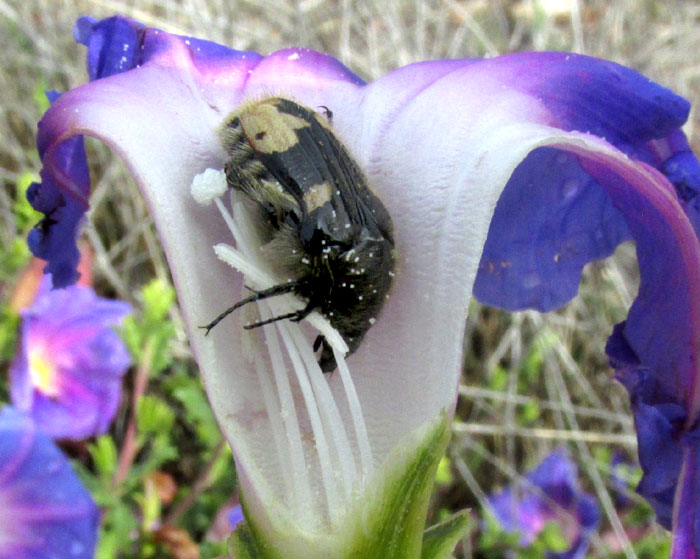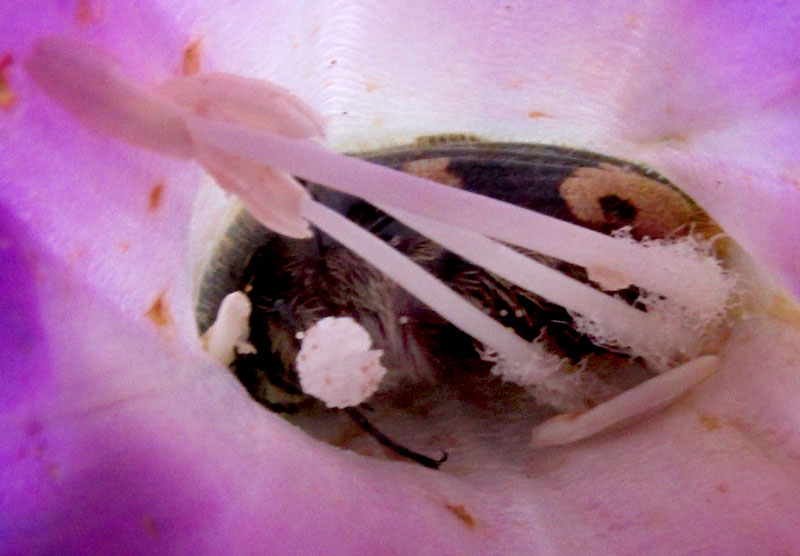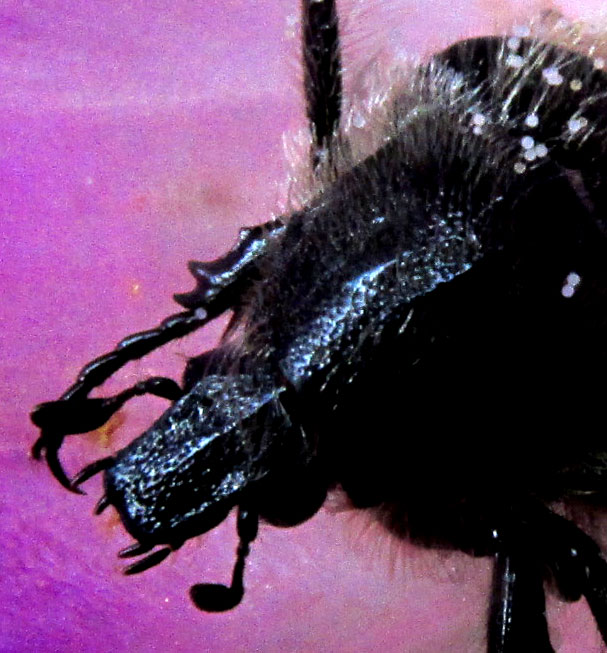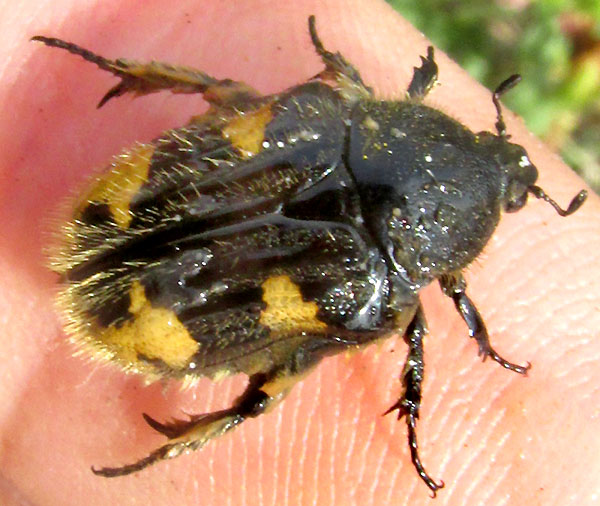Excerpts from Jim Conrad's
Naturalist Newsletter
entry dated August 16, 2022, issued from near Tequisquiapan, elevation about 1,900m (6200 ft), N20.565°, W99.890°, Querétaro state, MÉXICO
BUMBLEBEE FLOWER BEETLE

The morning after the first three-month-delayed good rain of the rainy season, the above beetle was found with its head stuck into the bottom of a large blossom of a Morning-glory Bush, Ipomoea stans, shown above. Had the beetle sheltered there overnight? The bush was loaded with dozens of blossoms, and over half harbored this beetle species inside them. All the beetles remained unmoving, even when I shook the blossoms. In fact, the one shown below remained quiet even as I broke open a flower:

It was around 10 AM, about 24°C (75°F), so not particularly chilly. Since the ingestion of certain morning-glory seeds produces effects similar to those of Psilocybe mushrooms and LSD, I wondered if maybe the beetles were stoned.
Or maybe they were just hiding, or quietly munching on pollen or flower parts. Some of them appeared to have eaten certain blossom tissue:

The above beetle has forced himself sideways into the bottom of the corolla tube, which normally is circular in cross section. At the right, lower corner of the tube, a pollen-producing anther has been dislodged from its stamens' filament. The spherical, grainy-surfaced item near the beetle's head is the stigma, which should stand atop a style rising well above the anthers at the picture's top, left. And the three stamens bearing those anthers look as if their bottoms may have been chewed off, causing them to tip over.
With enough of my bothering them, finally one beetle slowly emerged, pollen grains suspended on his hairs:

Coaxed onto my hand, he displayed a bold, distinctive pattern on his wing covers:

Master volunteer insect identifier Bea in Ontario, upon receiving the above picture, quickly identified our beetles as a bumblebee flower beetle, EUPHORIA BASALIS. The name bumblebee flower beetle appears to apply to all the species of Euphoria.
Fortunately, online it's possible to download Jesús Orozco's excellent 2012 study entitled "Monographic Revision of the American Genus Euphoria Burmeister, 1842 (Coleoptera: Scarabaeidae: Cenoniinae)," in which our particular bumblebee flower beetle is described in detail.
British evolutionary biologist and geneticist J.B.S. Haldane quipped that if a god or divine being had created all living organisms on Earth, then that creator must have an “inordinate fondness for beetles.” About one quarter of all animal species on Earth is a beetle, beetle species comprising the Beetle Order, Coleoptera. In the Beetle Order, the Scarab Beetle Family, the Scarabaeidae, as currently defined, embraces over 30,000 species. The Scarab Family is divided into various subfamilies and tribes. Our beetle belongs to the Flower Chafer subfamily Cetoniinae, home to about 4,000 species. Orozco's above-mentioned monograph recognizes 59 American Euphoria species. He also provides color photos of each species, and the images alone suffice to see that none of those other 58 species even comes close to looking like our Euphoria basalis.
Our Euphoria basalis has been documented in dry southwestern Texas not far from the Mexican border, but otherwise the species is found throughout mainland Mexico (not Baja or the Yucatan) in various habitats, including scrub forest, gardens, cultivated fields, grasslands and pine and oak forests, from sea level to 2600m (8500ft). It feeds on various kinds of flowers, including their petals and pollen. Sometimes it's considered an agricultural pest of cotton, melon, pumpkin and sunflowers.
Orozco in his 2012 work said that the life history for most species in the genus Euphoria is unknown. What was known at that time about our Euphoria basalis is copied above.
Therefore, here maybe we're adding something by documenting them in a Bush Morning-glory flower, apparently feeding on the sexual parts. Maybe the beetles had overnighted in the blossoms. And here's something extra: Many of the beetles inside their blossoms that morning bore wet mud, as if they'd just emerged from nearby dirt, or entered muddy and the night's rain wetted it. The above photo shows a little on the beetle's thorax.
And were the beetles stoned? ¿Quién sabe?
With such observations, bit by bit, a species' life history eventually is put together by someone lucky enough to do it.